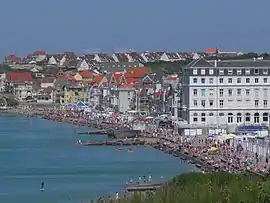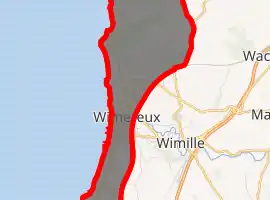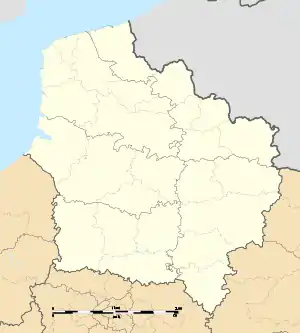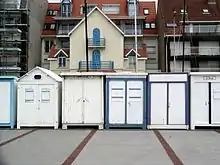Wimereux
Wimereux (French: [vim(ə)ʁø]; West Flemish: Wimeruwe) is a commune in the Pas-de-Calais department in the Hauts-de-France region of France.
Wimereux
Wimeruwe | |
|---|---|
 Wimereux | |
 Coat of arms | |
Location of Wimereux 
| |
 Wimereux  Wimereux | |
| Coordinates: 50°46′14″N 1°36′38″E | |
| Country | France |
| Region | Hauts-de-France |
| Department | Pas-de-Calais |
| Arrondissement | Boulogne-sur-Mer |
| Canton | Boulogne-sur-Mer-1 |
| Intercommunality | Boulonnais |
| Government | |
| • Mayor (2014-2020) | Francis Ruelle |
| Area 1 | 7.71 km2 (2.98 sq mi) |
| Population (2017-01-01)[1] | 6,575 |
| • Density | 850/km2 (2,200/sq mi) |
| Time zone | UTC+01:00 (CET) |
| • Summer (DST) | UTC+02:00 (CEST) |
| INSEE/Postal code | 62893 /62930 |
| Elevation | 0–71 m (0–233 ft) |
| 1 French Land Register data, which excludes lakes, ponds, glaciers > 1 km2 (0.386 sq mi or 247 acres) and river estuaries. | |
Geography
Wimereux is a coastal town situated some 5 kilometres (3 mi) north of Boulogne, at the junction of the D233 and the D940 roads, on the banks of the river Wimereux. The river Slack forms the northern boundary of the commune, the English Channel the western. Farming and tourism are its principal activities.
History
At Pointe-aux-Oies, dolmen can still be seen at a Stone Age prehistoric site.
Vauban built a coastal fort at the mouth of the river Wimereux, the ruins showed at low-tide until the 1940s. Napoleon ordered a port to be built here between 1803 and 1804, taking its name from the river. In 1840, the future Napoleon III, first president (and last monarch) of France, landed at Pointe aux Oies.
The territory of Wimereux originally belonged to the commune of Wimille, from which it separated on 28 May 1899. In the same year, the first radio link between France and England was established at Wimereux in March by Guglielmo Marconi.[2]
In the First World War, Boulogne and Wimereux formed an important hospital centre and until June 1918, the medical units used Wimereux communal cemetery for burials. Lady Hadfield set up and ran a Red Cross hospital here at her own expense for the treatment of wounded and sick servicemen.[3] Colonel John McCrae, the gunner and doctor who wrote the popular war poem "In Flanders Fields", served and died in the hospital and is buried here.
Wimereux was the headquarters of the Queen Mary's Army Auxiliary Corps. In 1916, Solomon J Solomon set up a Royal Engineers establishment, the Special Works Park, in a disused feldspar factory. Here were developed new military camouflage techniques and equipment for the British Army.[4] It became the General Headquarters of the British Army in 1919.
During the Second World War, German Naval Headquarters were situated on the northern side of the town. After D-Day, as Allied forces moved northwards, the town was shelled from Cap Gris Nez, and was re-taken by the Canadian 1st Army on 22 September 1944.
The seaside development was started during the Second Empire, resulting in a remarkable architectural ensemble of houses and buildings typical of the Belle Époque, which are still very well maintained to this day. Originally the secondary residence of wealthy families of Lille and Paris, Wimereux has become a residential suburb of Boulogne and also attracts Britons and Belgians who come to buy holiday homes or settle permanently.
Places of interest
- The church of the Immaculate Conception, dating from the twentieth century
- The nineteenth century chapel of Notre-Dame
- The Villa 'Les Mauriciens'
- The Commonwealth War Graves Commission cemetery
People
- William Morrison Wyllie, English artist
- Lionel Percy Smythe (stepson of William Morrison Wyllie), English landscape artist, lived here from 1879 to 1918.
- Alfred Mathieu Giard, zoologist and director of the marine research establishment at Wimereux.
- John McCrae, author of "In Flanders Fields", is buried in the CWGC cemetery.[5]
- Jack Lang, politician and one-time government minister.
- Jean-François Pilâtre de Rozier, aviation pioneer, crashed to his death from a balloon near Wimereux in June 1785.[6]
- Maurice Boitel, artist, exhibited here in the 1980s and 1990s.
Twin towns
Wimereux is twinned with the following cities:
 Herne Bay, Kent, England
Herne Bay, Kent, England Schmallenberg, Germany.
Schmallenberg, Germany.
Population
| Year | Pop. | ±% |
|---|---|---|
| 2006 | 7,410 | — |
| 2007 | 7,398 | −0.2% |
| 2008 | 7,386 | −0.2% |
| 2009 | 7,443 | +0.8% |
| 2010 | 7,442 | −0.0% |
| 2011 | 7,312 | −1.7% |
| 2012 | 7,161 | −2.1% |
| 2013 | 7,010 | −2.1% |
| 2014 | 6,996 | −0.2% |
| 2015 | 7,035 | +0.6% |
| 2016 | 6,795 | −3.4% |
Gallery
 The beach at Wimereux
The beach at Wimereux Beach huts
Beach huts.JPG.webp) The west front of the church
The west front of the church The war memorial
The war memorial The seafront promenade
The seafront promenade Villa «La Frégate»
Villa «La Frégate» Villas on the seafront
Villas on the seafront Plaque commemorating wireless link-up between France and England
Plaque commemorating wireless link-up between France and England High tide along the beachfront
High tide along the beachfront The beach crowded with people at lower tide
The beach crowded with people at lower tide
References
- "Populations légales 2017". INSEE. Retrieved 6 January 2020.
- "Guglielmo Marconi". National Trust. Retrieved 15 March 2016.
- "Lady Hadfield, Obituary". The Times. 8 November 1949.
- Rankin, Nicholas (2008). Churchill's Wizards - the British genius for deception, 1914 - 1945. London: Faber and Faber. p. 86. ISBN 978-0-571-22195-0.
- The CWGC cemetery
- Jean François Pilâtre de Rozier at Find A Grave
External links
| Wikimedia Commons has media related to Wimereux. |
- Website about Wimereux (English only)
- Official town website (French only)
- Official Tourist website (French only)
- Official website: Tourism in Boulogne and the Boulonnais region